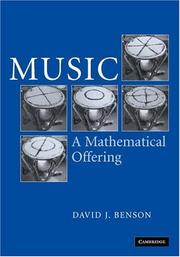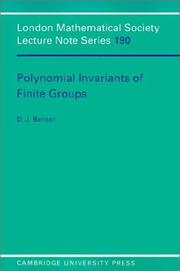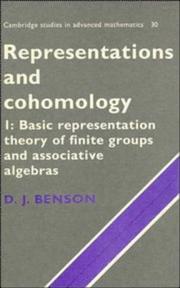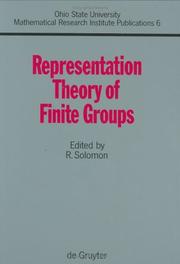| Listing 1 - 10 of 10 |
Sort by
|

ISBN: 9780521853873 0521853877 9780521619998 0521619998 9780511811722 9781139649254 1139649256 0511811721 9781139638791 1139638793 9781139641630 1139641638 1107165652 1107253837 1139637339 1299409229 1139648292 Year: 2008 Publisher: Cambridge, U.K. ; New York : Cambridge University Press,
Abstract | Keywords | Export | Availability | Bookmark
 Loading...
Loading...Choose an application
- Reference Manager
- EndNote
- RefWorks (Direct export to RefWorks)
Since the time of the Ancient Greeks, much has been written about the relation between mathematics and music: from harmony and number theory, to musical patterns and group theory. Benson provides a wealth of information here to enable the teacher, the student, or the interested amateur to understand, at varying levels of technicality, the real interplay between these two ancient disciplines. The story is long as well as broad and involves physics, biology, psycho acoustics, the history of science, and digital technology as well as, of course, mathematics and music. Starting with the structure of the human ear and its relationship with Fourier analysis, the story proceeds via the mathematics of musical instruments to the ideas of consonance and dissonance, and then to scales and temperaments. This is a must-have book if you want to know about the music of the spheres or digital music and many things in between.
Music --- Musical perception. --- Acoustics and physics. --- Mathematics. --- Musical perception --- Acoustics and physics --- Mathematics --- 78.86.1 --- Auditory perception --- Musical acoustics --- Physics --- Sound --- Monochord --- Psychological aspects --- Music theory --- Mathematical Sciences --- General and Others --- Music - Acoustics and physics --- Music - Mathematics

ISBN: 1139884999 1107366941 1107371597 1107362032 1107370329 1299404669 1107364485 0511565801 9781107362031 0521458862 9780521458863 9780511565809 Year: 1993 Volume: 190 Publisher: Cambridge ; New York : Cambridge University Press,
Abstract | Keywords | Export | Availability | Bookmark
 Loading...
Loading...Choose an application
- Reference Manager
- EndNote
- RefWorks (Direct export to RefWorks)
This is the first book to deal with invariant theory and the representations of finite groups. By restricting attention to finite groups Dr Benson is able to avoid recourse to the technical machinery of algebraic groups, and he develops the necessary results from commutative algebra as he proceeds. Thus the book should be accessible to graduate students. In detail, the book contains an account of invariant theory for the action of a finite group on the ring of polynomial functions on a linear representation, both in characteristic zero and characteristic p. Special attention is paid to the role played by pseudoreflections, which arise because they correspond to the divisors in the polynomial ring which ramify over the invariants. Also included is a new proof by Crawley-Boevey and the author of the Carlisle-Kropholler conjecture. This volume will appeal to all algebraists, but especially those working in representation theory, group theory, and commutative or homological algebra.
Invariants. --- Finite groups. --- Divisor theory. --- Categories (Mathematics) --- Ideals (Algebra) --- Modules (Algebra) --- Groups, Finite --- Group theory --- Groups (Mathematics)
Book
ISBN: 1316805654 1316804925 1316795691 1316806383 1316807118 1316809307 1316800547 9781316807118 9781316809303 9781316795699 9781107174177 1107174171 Year: 2017 Publisher: Cambridge : Cambridge University Press,
Abstract | Keywords | Export | Availability | Bookmark
 Loading...
Loading...Choose an application
- Reference Manager
- EndNote
- RefWorks (Direct export to RefWorks)
Questions about modular representation theory of finite groups can often be reduced to elementary abelian subgroups. This is the first book to offer a detailed study of the representation theory of elementary abelian groups, bringing together information from many papers and journals, as well as unpublished research. Special attention is given to recent work on modules of constant Jordan type, and the methods involve producing and examining vector bundles on projective space and their Chern classes. Extensive background material is provided, which will help the reader to understand vector bundles and their Chern classes from an algebraic point of view, and to apply this to modular representation theory of elementary abelian groups. The final section, addressing problems and directions for future research, will also help to stimulate further developments in the subject. With no similar books on the market, this will be an invaluable resource for graduate students and researchers working in representation theory.
Abelian p-groups. --- Abelian groups. --- Vector bundles. --- Fiber spaces (Mathematics) --- p-groups, Abelian --- Primary Abelian groups --- Primary groups, Abelian --- Abelian groups --- Commutative groups --- Group theory

ISBN: 0521361346 0521361354 Year: 1991 Publisher: Cambridge Cambridge University press
Abstract | Keywords | Export | Availability | Bookmark
 Loading...
Loading...Choose an application
- Reference Manager
- EndNote
- RefWorks (Direct export to RefWorks)
Homology theory --- Representations of algebras --- Representations of groups
Book
ISBN: 0511623615 Year: 1995 Publisher: Cambridge : Cambridge University Press,
Abstract | Keywords | Export | Availability | Bookmark
 Loading...
Loading...Choose an application
- Reference Manager
- EndNote
- RefWorks (Direct export to RefWorks)
This is the first of two volumes which will provide an introduction to modern developments in the representation theory of finite groups and associative algebras. The subject is viewed from the perspective of homological algebra and the theory of representations of finite dimensional algebras; the author emphasises modular representations and the homological algebra associated with their categories. This volume is self-contained and independent of its successor, being primarily concerned with the exposition of the necessary background material. The heart of the book is a lengthy introduction to the (Auslander-Reiten) representation theory of finite dimensional algebras, in which the techniques of quivers with relations and almost split sequences are discussed in detail. Much of the material presented here has never appeared in book form. Consequently students and research workers studying group theory and indeed algebra in general will be grateful to Dr Benson for supplying an exposition of a good deal of the essential results of modern representation theory.
Representations of groups. --- Representations of algebras. --- Homology theory.
Book
ISBN: 0511874812 0511623623 Year: 1991 Publisher: Cambridge : Cambridge University Press,
Abstract | Keywords | Export | Availability | Bookmark
 Loading...
Loading...Choose an application
- Reference Manager
- EndNote
- RefWorks (Direct export to RefWorks)
This is the second of two volumes which will provide an introduction to modern developments in the representation theory of finite groups and associative algebras. The subject is viewed from the perspective of homological algebra and the theory of representations of finite dimensional algebras; the author emphasises modular representations and the homological algebra associated with their categories. This volume concentrates on the cohomology of groups, always with representations in view, however. It begins with a background reference chapter, then proceeds to an overview of the algebraic topology and K-theory associated with cohomology of groups, especially the work of Quillen. Later chapters look at algebraic and topological proofs of the finite generation of the cohomology ring of a finite group, and an algebraic approach to the Steenrod operations in group cohomology. The book cumulates in a chapter dealing with the theory of varieties for modules. Much of the material presented here has never appeared before in book form. Consequently students and research workers studying group theory, and indeed algebra in general, will be grateful to Dr Benson for supplying an exposition of a good deal of the essential results of modern representation theory.
Representations of groups. --- Representations of algebras. --- Homology theory.
Book
Abstract | Keywords | Export | Availability | Bookmark
 Loading...
Loading...Choose an application
- Reference Manager
- EndNote
- RefWorks (Direct export to RefWorks)
Book
Abstract | Keywords | Export | Availability | Bookmark
 Loading...
Loading...Choose an application
- Reference Manager
- EndNote
- RefWorks (Direct export to RefWorks)
Book

ISBN: 9783110806298 Year: 2012 Publisher: Berlin Boston
Abstract | Keywords | Export | Availability | Bookmark
 Loading...
Loading...Choose an application
- Reference Manager
- EndNote
- RefWorks (Direct export to RefWorks)


ISBN: 9783110806298 9783110158069 Year: 2012 Publisher: Berlin ;; Boston De Gruyter
Abstract | Keywords | Export | Availability | Bookmark
 Loading...
Loading...Choose an application
- Reference Manager
- EndNote
- RefWorks (Direct export to RefWorks)
| Listing 1 - 10 of 10 |
Sort by
|

 Search
Search Feedback
Feedback About UniCat
About UniCat  Help
Help News
News